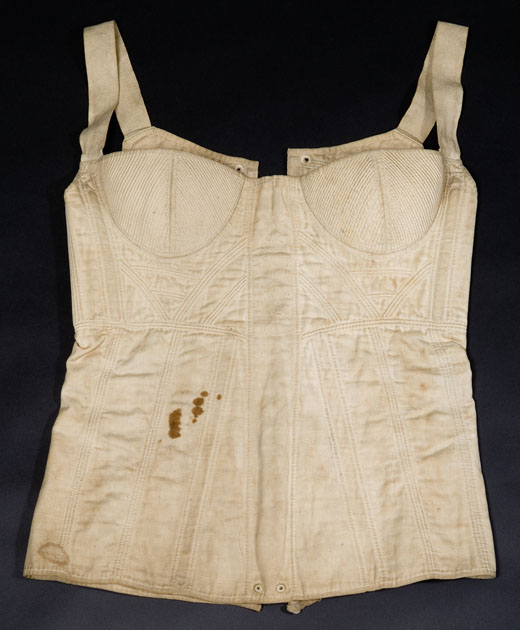Details
- Object type
corset; stays
- Date
circa 1820-1830
- Materials
cotton, hand-stitched
- Dimensions
bust: 800 mm; waist: 650 mm; hips: 850 mm; centre front: 390 mm; centre back 420 mm; weight: 251.2 g
- Description
-
Woman’s corset or stays in white cotton twill stiffened with whalebone and cording. Straight-cut panels one at front and two at back with outer and lining cut to same shape. Shoulder straps 28 mm wide in cotton twill tape attached to main corset. Two cups constructed from two triangular panels each, cord quilted and attached to bodice. Along upper edge of bust is a narrow twisted tape drawstring allowing for further fitting by tying to short tapes at sides of bust. Channel for removal busk (missing) down centre front 40 mm wide with two eyelets at bottom. Panels at front have two channels running diagonally (missing boning), with two short channels down sides with whalebone. Back panels have two channels near opening with whale bone (all but one missing) and rows of eyelets for fastening with a long lace (missing). Majority of stitching in back stitch, but front and back panels have been joined in some places with stab stitch. The cups and shoulder straps are attached with over-sewing.
Structured corsets were worn by women to support their posture, but also to provide a suitable foundation garment for the outer gown or dress. During the 1700s they were known as stays, but in the early 1800s the term ‘corset’ was introduced.
This is the earliest corset in Glasgow Museums’ collection. The white cotton twill is shaped and strengthened by cord quilting rather than boning, especially on the supportive cups. However, the narrow panel down the centre front would have held a busk, a long piece of wood or ivory that would have helped to the corset and therefore the dress stay flat in front. During the 1820s the waist was returning to a natural line, but the emphasis was still on creating a long slim line rather than the hour-glass figure that became fashionable during the mid-1800s.
- Credit Line/Donor
Gifted by Mrs McSporran, 1948
- ID Number
E.1948.31.a
- Location
In storage
